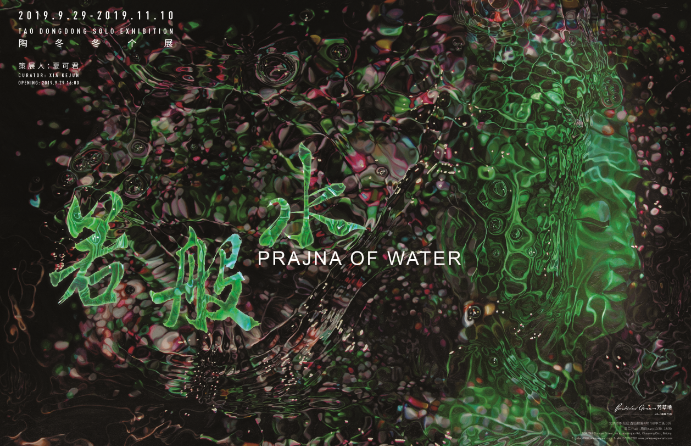It is an honor for Parkview Green Art·798 to announce that the solo exhibition Prajna of Water of artist Tao Dongdong will open on September 29th, 2019. For Tao, "water" marks the boundary between virtual and real world, between facts and illusions. Prajna, as the ultimate wisdom of Buddhism, represents the contemporary attitude and understanding of the truth. Taking paintings as the main media, the two series of Holy Portrait and Spiritual Mountains express experiences and thoughts of Tao Dongdong about the past, the notions of time and space, the concepts of ideology and aesthetics. The exhibition will last until November 10th, 2019.
The works of Tao Dongdong usually take the actual objects as starting point: the original image then goes through a process of abstraction and spiritual sublimation through water. From the early Holy Portrait series to the current Spiritual Mountains series, the relation between water and other elements in the painting has always been the focus of Tao's attention. In the Holy Portrait series, Tao places the portraits of figures such as Buddha, Guan Gong and Flower Goddess in the water ripples, transforming the concrete visual narration into the narration articulated in multiple levels, so that the thematic object, while retaining the actual physical norms of rippling and transparency, can create the poetic realm and give rise to spiritual extensions. In recent years, Tao depicted the mountainous and watery spaces by means of water, based on his years' understanding and perception of traditional Chinese landscape paintings and has created series of oil paintings with his strong personal characteristics. In the latest series, the morphology of water turns from the glowing reflective surface into lingering clouds and fog. In the paintings, the looming mountains and rivers are surrounded by clouds and the spiritual power, like in Holy Portraits. This represents Tao Dongdong's further understanding and perception of "water".
Prajna signifies the Buddhist wisdom to conceptualize everything in the world and understand the origin of it. Although Tao's artworks are not about religion, he shares the philosophy similiar to that of Prajna in Buddhism. The exhibition carefully organizes the classical and latest works of Tao Dongdong to present the Prajna spirit in his works, namely the effort to seek truth through the paintings themselves. Close yet far, true yet illusionary, be it the truth or beauty, they can only be perceived yet not be touched.
Tao Dongdong's paintings demonstrate the contemporary transformation of oriental wisdom. Their significance lies in the artist's concentrated observation method: it absorbs the flowing brightness in western religions, reflects the subtle vibration of cosmic messages. Through his paintings, the viewers are also confronted with the inner and spiritual transformation caused by the crisis of our time. In an age where people's minds experiment a condition of void and emptiness, paintings represent an adjustment and a transformation of our souls. We shall enter the field of life energy conversion, acquire a spiritual force of Prajna, and integrate it into the complexity of life.
It is an honor for Parkview Green Art·798 to announce that the solo exhibition Prajna of Water of artist Tao Dongdong will open on September 29th, 2019. For Tao, "water" marks the boundary between virtual and real world, between facts and illusions. Prajna, as the ultimate wisdom of Buddhism, represents the contemporary attitude and understanding of the truth. Taking paintings as the main media, the two series of Holy Portrait and Spiritual Mountains express experiences and thoughts of Tao Dongdong about the past, the notions of time and space, the concepts of ideology and aesthetics. The exhibition will last until November 10th, 2019.
The works of Tao Dongdong usually take the actual objects as starting point: the original image then goes through a process of abstraction and spiritual sublimation through water. From the early Holy Portrait series to the current Spiritual Mountains series, the relation between water and other elements in the painting has always been the focus of Tao's attention. In the Holy Portrait series, Tao places the portraits of figures such as Buddha, Guan Gong and Flower Goddess in the water ripples, transforming the concrete visual narration into the narration articulated in multiple levels, so that the thematic object, while retaining the actual physical norms of rippling and transparency, can create the poetic realm and give rise to spiritual extensions. In recent years, Tao depicted the mountainous and watery spaces by means of water, based on his years' understanding and perception of traditional Chinese landscape paintings and has created series of oil paintings with his strong personal characteristics. In the latest series, the morphology of water turns from the glowing reflective surface into lingering clouds and fog. In the paintings, the looming mountains and rivers are surrounded by clouds and the spiritual power, like in Holy Portraits. This represents Tao Dongdong's further understanding and perception of "water".
Prajna signifies the Buddhist wisdom to conceptualize everything in the world and understand the origin of it. Although Tao's artworks are not about religion, he shares the philosophy similiar to that of Prajna in Buddhism. The exhibition carefully organizes the classical and latest works of Tao Dongdong to present the Prajna spirit in his works, namely the effort to seek truth through the paintings themselves. Close yet far, true yet illusionary, be it the truth or beauty, they can only be perceived yet not be touched.
Tao Dongdong's paintings demonstrate the contemporary transformation of oriental wisdom. Their significance lies in the artist's concentrated observation method: it absorbs the flowing brightness in western religions, reflects the subtle vibration of cosmic messages. Through his paintings, the viewers are also confronted with the inner and spiritual transformation caused by the crisis of our time. In an age where people's minds experiment a condition of void and emptiness, paintings represent an adjustment and a transformation of our souls. We shall enter the field of life energy conversion, acquire a spiritual force of Prajna, and integrate it into the complexity of life.

